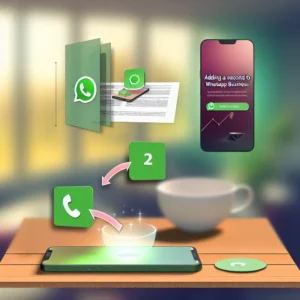In today’s fast-paced digital world, businesses face the ongoing challenge of maintaining effective communication with customers. With increasing consumer demands for instant responses, traditional customer service methods often fall short. The need to optimize customer interactions has never been more urgent.
Many marketing and development teams struggle to create efficient workflows that keep pace with customer expectations. This gap leads to missed opportunities and disengaged users. To overcome these hurdles, companies turn to automation solutions like Typebot.
Typebot offers an innovative approach to chatbot development, enabling professionals to create engaging conversation flows without extensive coding knowledge. This article will guide you through Typebot’s capabilities and focus on how it can transform your customer interactions and automate processes effectively.
Introduction to Typebot and Its Capabilities
Typebot is a powerful tool that enhances communication and customer interaction through chatbots. Its intuitive user interface allows you to design engaging chatbot flows easily. This capability is crucial if you want to automate communication and optimize customer service.
“Our customer satisfaction skyrocketed after implementing Typebot. It’s a game-changer in support automation!” – SwiftTech Solutions
- 30% Increase in Customer Satisfaction
- Transformation of Customer Interactions
Typebot develops diverse chatbot flows tailored to various aspects of customer interaction. Understanding how to create flows effectively enables you to leverage Typebot’s capabilities to improve marketing strategies and operational efficiency. Comfort Clinic improved patient retention by 25% by using Typebot to automate appointment scheduling and FAQs.
Additionally, Typebot supports integration with channels like WhatsApp. This versatility helps reach customers where they are most active and benefits professionals who want to expand their automation efforts while enhancing responsiveness and service quality. For more on using automation solutions, keep up with the latest trends.
“Typebot’s resources perfectly guided us to maximize our chatbot’s potential and enhance user engagement.” – Marketing Team, Comfort Clinic
Typebot also provides extensive resources and documentation that serve as comprehensive guides for users. By leveraging these resources, you can maximize your chatbot’s potential and ensure your flows are functional and optimized for the best user engagement.
Understanding the Basics of Chatbot Flows
Creating flows in Typebot is crucial for building a responsive chatbot experience. Chatbot flows act as the architecture that smoothly guides user interactions. Effective flows ensure users receive the information they need efficiently.
- Define your chatbot’s main goals
- Outline the user journey
- Configure nodes within Typebot
“Our sales increased by 15% after clearly defining our chatbot’s goals. Typebot made it easy!” – EcoRetail
Next, outline the user journey. Sketching possible paths helps visualize how users might interact with your chatbot. Documenting each step from greetings to potential queries can be helpful at this stage, making it easier to translate ideas into usable flows in Typebot.
Once you’ve defined the user journey, configure the nodes within Typebot. Each node acts as a decision point where the user receives information or chooses a path. Implement conditional statements that respond to user queries to boost engagement. TravelBuddy saw a 20% reduction in customer inquiries by using conditional logic to guide users through travel-related questions.
Finally, integrate buttons, quick replies, and multimedia into your flows. These elements enrich user interaction and simplify user decisions. Typebot enables seamless integration of these features, resulting in a more engaging experience.
Why Use Typebot for Automation?
Typebot stands out as a powerful tool for creating flows that optimize processes and improve user experiences. By automating repetitive tasks, you increase efficiency and productivity, allowing your team to focus on strategic initiatives. Explore tools for automated customer care to enhance your services.
“Personalizing our chatbot interactions significantly boosted engagement, with a 40% increase in the use of our online services!” – CityLibrary
- Design flexibility with customization
- User-friendly interface requiring no programming skills
Using Typebot offers design flexibility. You can customize chatbot flows to suit your audience and ensure personalized interactions. Such tailored experiences have significantly increased customer engagement; for example, CityLibrary reported a 40% rise in online service usage after personalizing chatbot interactions.
Unlike traditional automation methods, Typebot’s user-friendly interface allows you to create and modify flows without extensive programming knowledge. This agility enables companies to quickly adapt to market changes and customer needs to stay ahead of the competition.
“Integrating Typebot with WhatsApp improved our response rate by 35%. It’s critical for our customer communication.” – Lemonade Stand
Moreover, Typebot offers monitoring and analytics tools that allow businesses to gain insights into customer behavior and preferences. This data-driven approach refines marketing strategies, improves customer service measures, and ultimately boosts ROI.
Step 1: Setting Up Your Typebot Account
The first step to creating flows in Typebot is to set up your account effectively. Start by visiting the Typebot website and registering. After signing up, explore the dashboard options to customize key preferences tailored to your needs.
- Visit the Typebot website and sign in
- Verify your email address for full functionality
- Explore the dashboard to set up your first chatbot
Confirm your email address with the verification email from Typebot to unlock full functionality. After confirmation, return to your dashboard to set up your first chatbot.
Focus on the “Create New Flow” button to initiate the chatbot design process. Typebot guides you through prompts and templates that optimize this experience. Familiarize yourself with these tools to boost your productivity in flow creation.
Also, note the integration options offered by Typebot. Linking your WhatsApp chatbot can significantly enhance communication. Ensure all required APIs are correctly entered to guarantee smooth interactions.
Once you complete these steps, you have a solid foundation for creating flows in Typebot. Dive deeper into designing and implementing effective chatbot flows aligned with your business goals.
Step 2: Designing Your First Flow
Designing flows is critical for building effective chatbots. Access the Typebot interface and navigate to the Flows section to get a blank template ready for your creativity.
- Define the starting point of your flow
- Outline the main actions within your flow
- Focus on conditions that control the flow direction
Start by defining the starting point of your flow as it sets the context for the user journey. Choose triggers such as incoming messages or button presses, which influence how users interact with your chatbot. FitnessHub increased user retention by 30% after refining their flow starting points based on behavioral user analysis.
Next, outline the main actions within your flow. Actions can include sending messages or integrating APIs. Consider user needs and the information to convey by designing branching paths that lead users in different directions based on their responses.
After setting the actions, focus on the conditions that control the flow direction. Implement decision patterns to create branching paths based on user requests, enhancing the user experience through personalized interactions.
“Testing our flow with real users revealed valuable insights that revolutionized our chatbot experience!” – Feedback from beta participants
Testing your flow is crucial. Typebot provides a preview feature to simulate user interactions. Identify areas for improvement, refine message phrasing, and enhance user journeys to effectively reach your automation goals.
Step 3: Adding Conditional Logic to Your Flows
Integrating conditional logic is essential for creating dynamic chatbot experiences. This setup allows your bot to respond differently to user queries and improve interaction. Use “if-then” statements to evaluate user requests against predefined criteria.
- Define conditions to create branches in your flows
- Test your flows thoroughly to ensure functionality
- Consider nested conditions for complex scenarios
“After adding logic to our flows, we saw a significant increase in user satisfaction.” – Insights from beta testers
Clearly define conditions to create branches in your flows. For example, direct users interested in Product A to further queries about A, while steering those interested in Product B elsewhere. This logical structuring ensures coherent, personalized conversations.
Test your flows thoroughly. Simulate conversations to check if conditions work correctly. Debugging at this stage greatly impacts user experience. A well-tested flow leads to higher satisfaction and achieves automation goals.
Consider using nested conditions for complex scenarios to improve the bot’s ability to provide relevant information. This approach allows multiple conditions to determine flow outcomes, making your Typebot more powerful and adaptable.
Effectively using conditional logic improves user experience as you build your Typebot flows. A mature chatbot can handle a variety of requests and significantly enhance your automation system’s performance.
Step 4: Testing Your Flow for Optimal Performance
Testing your flow is vital to ensure the chatbot’s functionality. Start by interacting with the flow as an end user and simulating various scenarios to cover possible interactions.
- Use built-in testing features to identify issues
- Gather feedback from colleagues or beta testers
- Implement tracking metrics to monitor user interactions
Focus on the logic and responses encoded in the Typebot guide. Use built-in testing features to quickly identify issues and make necessary adjustments before rollout. Gathering feedback from colleagues or beta testers can uncover previously unknown problems and improvement opportunities.
Implement tracking metrics to monitor users’ interactions with your chatbot. This data highlights areas needing optimization. If users repeatedly ask the same questions, consider adjusting your automation accordingly.
After making adjustments, test the flow multiple times. Each iteration should demonstrate improvements and ensure a smooth user experience. Create flows that not only work correctly but also engage users effectively.
Deploying Your Chatbot Flow Across Different Channels
Deploying your chatbot flow across different channels maximizes user engagement. After designing your flows, distribute them on platforms like WhatsApp to improve accessibility.
- Identify channels for deployment
- Use the official API for WhatsApp integration
- Test functionality across each channel
Identify deployment channels and note their requirements. For WhatsApp, use the official API to integrate your Typebot flow. Register your business, obtain the necessary API key, and connect your Typebot flows for seamless user interactions.
Focus on automated messaging options by customizing responses based on user queries. Creating different paths within your flows caters to diverse user needs and increases customer satisfaction.
Testing your chatbot flows across each channel ensures functionality. Use debugging features to resolve deployment issues while monitoring user interactions for continuous improvement.
Advanced Tips for Optimizing Your Typebot Flows
Creating flows requires maximizing their potential through advanced techniques. Use conditional logic to personalize user experiences based on inputs, leading to more relevant interactions. Segment users with branches that guide them to desired actions.
“Regularly testing our flows allowed us to effectively use user feedback and significantly improve performance.” – Analytics Team
- Integrate variables to maintain context
- Consider A/B testing for different flow variations
- Use Typebot’s analytics tools for continuous optimization
Integrate variables to maintain context during conversations. This method allows the chatbot to remember previous interactions and improve the user experience. Manipulate these variables to trigger different flows based on responses.
Regularly test and iterate your flows, identifying bottlenecks with Typebot’s preview feature. Consider A/B testing with different flow variations to gain valuable insights into user behavior.
Integrating external APIs enhances your Typebot’s functionality by enabling real-time data retrieval for interactions. Ensure you incorporate API calls into your chatbot processes to deepen engagement.
Use Typebot’s analytics tools for continuous optimization. Analyze performance data to identify patterns in flow effectiveness. Regular refinement based on these insights will align your chatbot flows with user expectations.
Common Mistakes to Avoid When Creating Flows in Typebot
Creating flows in Typebot combines creativity and technology, but common mistakes can lead to inefficient setups. Users must avoid pitfalls to improve their chatbot flows effectively.
- Not defining a clear goal for each flow
- Overlooking the user experience during design
- Insufficient error handling
“We learned that proper error handling significantly increased user trust in our chatbot.” – Technical Support Insights
Failing to define a clear goal for each flow can cause confusion. Outline desired outcomes before starting the flow creation process. This is critical to simplifying user requests and guiding them effectively.
Neglecting user experience is another common mistake. Flows must be intuitive; complicated sequences can lead to drop-offs. Testing with real users helps identify issues and improve engagement.
Insufficient error handling undermines flow design. Anticipate user mistakes and provide support for correction. Fallback messages and clarification options enhance user experience and reduce frustration.
Ignoring integrations limits flow potential. Typebot connects with various services; not leveraging this can miss data collection opportunities. Explore integration options to maximize efficiency.
Skipping the testing phase can cause significant setbacks. A thorough testing process identifies errors and ensures flows function as intended. Regular review cycles of your Typebot creations ensure effectiveness.
Conclusion and Next Steps
Creating flows in Typebot is essential to building effective chatbot automations. This guide outlined the necessary steps and optimization approaches for better user engagement and accuracy.
“Regularly refining our flows based on user feedback has kept our chatbot relevant and effective!” – Continuous Improvement Team
The key to successful chatbot flow creation lies in understanding user intent and designing seamless experiences. By leveraging Typebot’s features, you can build reactive chatbot flows that enhance interaction. Regularly testing and refining flows reveals improvement opportunities over time.
Next, explore Typebot’s advanced features and third-party integrations to enhance functionality. Using APIs enables your chatbot to provide relevant data within conversations.
Engage in community discussions to gain valuable tips and insights. Joining platforms dedicated to chatbot development opens opportunities for collaboration and learning from others’ experiences.
Finally, regularly review Typebot’s documentation for updates. Adjusting flows to incorporate new features keeps your chatbot relevant and user-friendly. Don’t forget to explore the benefits of integrating an AI-powered WhatsApp chatbot to expand your reach and offer users an engaging experience on their mobile devices.









